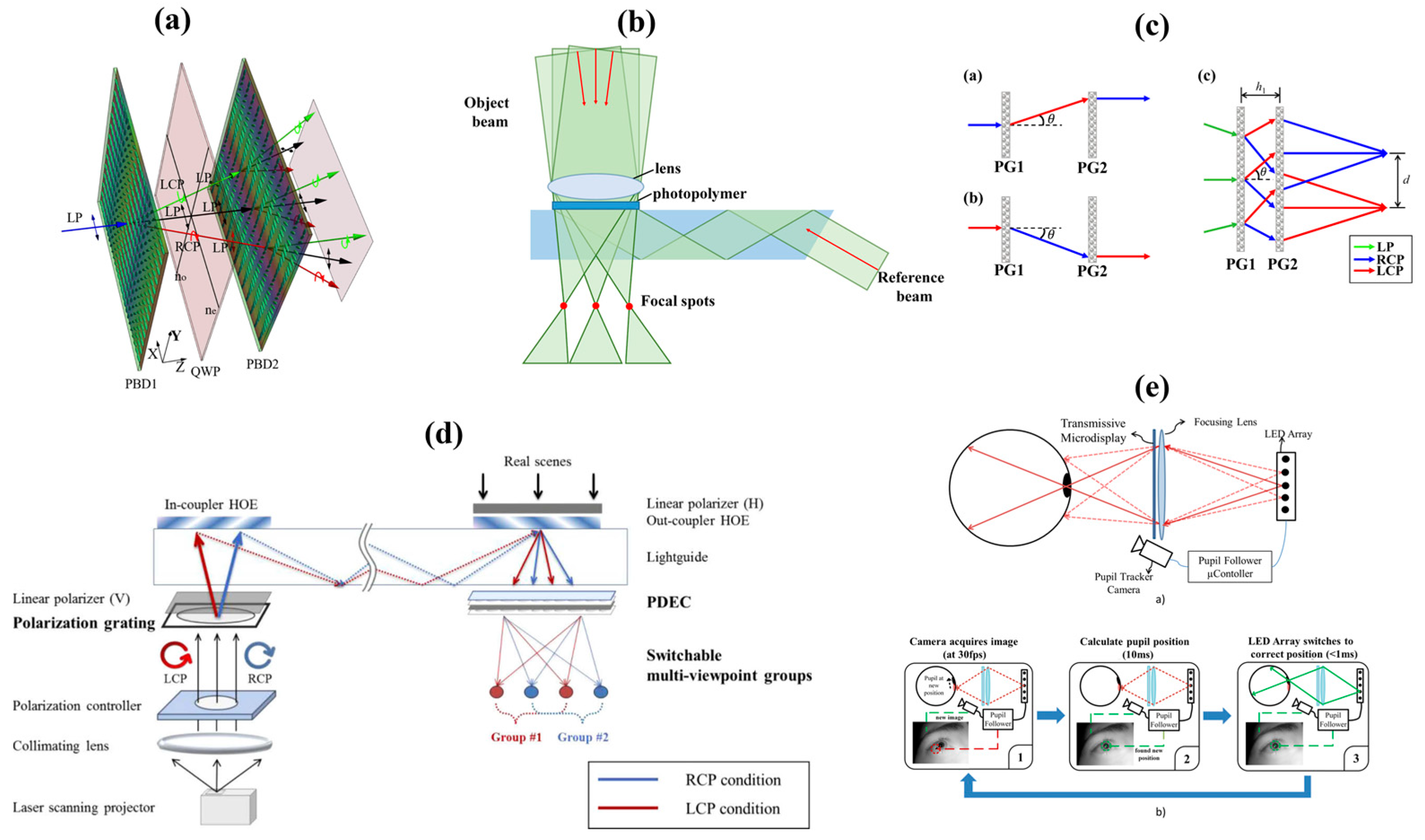Techniques to Expand the Exit Pupil of Maxwellian Display: A Review †
Abstract
:1. Introduction
2. Techniques
2.1. Static Viewpoints
2.2. Tunable Viewpoints

2.3. Dynamic Viewpoints
3. Conclusions
Author Contributions
Funding
Institutional Review Board Statement
Informed Consent Statement
Data Availability Statement
Conflicts of Interest
References
- He, Z.; Sui, X.; Jin, G.; Cao, L. Progress in virtual reality and augmented reality based on holographic display. Appl. Opt. 2019, 58, A74–A81. [Google Scholar] [CrossRef] [PubMed]
- Lin, T.; Zhan, T.; Zou, J.; Fan, F.; Wu, S. Maxwellian near-eye display with an expanded eyebox. Opt. Express 2020, 28, 38616–38625. [Google Scholar] [CrossRef] [PubMed]
- Westheimer, G. The Maxwellian view. Vision Res. 1966, 6, 669–682. [Google Scholar] [CrossRef] [PubMed]
- Kim, S.B.; Park, J.H. Optical see-through Maxwellian near-to-eye display with an enlarged eyebox. Opt. Lett. 2018, 43, 767–770. [Google Scholar] [CrossRef] [PubMed]
- Choi, M.H.; Ju, Y.G.; Park, J.H. Holographic near-eye display with continuously expanded eyebox using two-dimensional replication and angular spectrum wrapping. Opt. Express 2020, 28, 533–547. [Google Scholar] [CrossRef] [PubMed]
- Shrestha, P.K.; Pryn, M.J.; Jia, J.; Chen, J.S.; Fructuoso, H.N.; Boev, A.; Zhang, Q.; Chu, D. Accommodation-free head mounted display with comfortable 3D perception and an enlarged eye-box. Research 2019, 2019, 9273723. [Google Scholar] [CrossRef] [PubMed]
- Chang, C.; Cui, W.; Park, J.; Gao, L. Computational holographic Maxwellian near-eye display with an expanded eyebox. Sci. Rep. 2019, 9, 18749. [Google Scholar] [CrossRef] [PubMed]
- Kaur, R.; Pensia, L.; Singh, O.; Das, B.; Kumar, R. Study of wavelength dependency on diffraction efficiency of volume holographic gratings based couplers in waveguide displays. In Computational Optical Sensing and Imaging; Optica Publishing Group: Vancouver, BC, Canada, 2022. [Google Scholar]
- Jo, Y.; Yoo, C.; Bang, K.; Lee, B.; Lee, B. Eye-box extended retinal projection type near-eye display with multiple independent viewpoints. Appl. Opt. 2021, 60, A268–A276. [Google Scholar] [CrossRef] [PubMed]
- Park, J.H.; Kim, S.B. Optical see-through holographic near-eye-display with eyebox steering and depth of field control. Opt. Express 2018, 26, 27076–27088. [Google Scholar] [CrossRef] [PubMed]
- Shi, X.; Liu, J.; Zhang, Z.; Zhao, Z.; Zhang, S. Extending eyebox with tunable viewpoints for see-through near-eye display. Opt. Express 2021, 29, 11613–11626. [Google Scholar] [CrossRef] [PubMed]
- Zhang, S.; Zhang, Z.; Liu, J. Adjustable and continuous eyebox replication for a holographic Maxwellian near-eye display. Opt. Lett. 2022, 47, 445–448. [Google Scholar] [CrossRef] [PubMed]
- Yoo, C.; Chae, M.; Moon, S.; Lee, B. Retinal projection type lightguide-based near-eye display with switchable viewpoints. Opt. Express 2020, 28, 3116–3135. [Google Scholar] [CrossRef] [PubMed]
- Hedili, M.K.; Soner, B.; Ulusoy, E.; Urey, H. Light-efficient augmented reality display with steerable eyebox. Opt. Express 2019, 27, 12572–12581. [Google Scholar] [CrossRef] [PubMed]
- Jang, C.; Bang, K.; Moon, S.; Kim, J.; Lee, S.; Lee, B. Retinal 3D: Augmented reality near-eye display via pupil-tracked light field projection on retina. ACM Trans. Graph. 2017, 36, 1–13. [Google Scholar] [CrossRef]
- Takaki, Y.; Fujimoto, N. Flexible retinal image formation by holographic Maxwellian-view display. Opt. Express 2018, 26, 22985–22999. [Google Scholar] [CrossRef] [PubMed]
- Jang, C.; Bang, K.; Li, G.; Lee, B. Holographic near-eye display with expanded eye-box. ACM Trans. Graph. 2018, 37, 1–14. [Google Scholar] [CrossRef]
- Kim, J.; Jeong, Y.; Stengel, M.; Aksit, K.; Albert, R.A.; Boudaoud, B.; Greer, T.; Kim, J.; Lopes, W.; Majercik, Z. Foveated AR: Dynamically-foveated augmented reality display. ACM Trans. Graph. 2019, 38, 99. [Google Scholar] [CrossRef]
- Xiong, J.; Li, Y.; Li, K.; Wu, S.T. Aberration-free pupil steerable Maxwellian display for augmented reality with cholesteric liquid crystal holographic lenses. Opt. Lett. 2021, 46, 1760–1763. [Google Scholar] [CrossRef] [PubMed]
Disclaimer/Publisher’s Note: The statements, opinions and data contained in all publications are solely those of the individual author(s) and contributor(s) and not of MDPI and/or the editor(s). MDPI and/or the editor(s) disclaim responsibility for any injury to people or property resulting from any ideas, methods, instructions or products referred to in the content. |
© 2023 by the authors. Licensee MDPI, Basel, Switzerland. This article is an open access article distributed under the terms and conditions of the Creative Commons Attribution (CC BY) license (https://creativecommons.org/licenses/by/4.0/).
Share and Cite
Rajveer, K.; Raj, K. Techniques to Expand the Exit Pupil of Maxwellian Display: A Review. Eng. Proc. 2023, 34, 13. https://doi.org/10.3390/HMAM2-14128
Rajveer K, Raj K. Techniques to Expand the Exit Pupil of Maxwellian Display: A Review. Engineering Proceedings. 2023; 34(1):13. https://doi.org/10.3390/HMAM2-14128
Chicago/Turabian StyleRajveer, Kaur, and Kumar Raj. 2023. "Techniques to Expand the Exit Pupil of Maxwellian Display: A Review" Engineering Proceedings 34, no. 1: 13. https://doi.org/10.3390/HMAM2-14128
APA StyleRajveer, K., & Raj, K. (2023). Techniques to Expand the Exit Pupil of Maxwellian Display: A Review. Engineering Proceedings, 34(1), 13. https://doi.org/10.3390/HMAM2-14128




